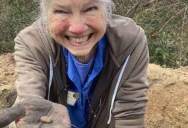Archaeologists Say They’ve Learned More About The Lost Colony Of Roanoke

What happened to the first established US colony is one of the most enduring mysteries in modern history.
The inhabitants of the Lost Colony of Roanoke could have perished, they could have been assimilated into local native tribes, they could have traveled to a Spanish settlement, etc etc – but with all of the very educated guesses, no one knows for certain.
Now, archaeologists say they have more pieces of the puzzle.
In 1587, English colonizers led by John White landed on Roanoke Island. They were the second attempt at forming a settlement; the first had failed 2 years previous.

The new settlers thought they were better prepared, but it wasn’t long before a lack of provisions, an inability to grow food, and a rocky relationship with the local indigenous tribes began to take their toll.
John White returned to England to request more help, leaving the rest of the community (including his wife and children, plus his granddaughter) behind to fend for themselves.
White’s granddaughter, Virginia Dare, was the first English child born in North America.
White’s return was significantly delayed by war with Spain, and when he finally made it back 3 years later, Roanoke was a ghost town.
No bodies, no graves, no note – save the words “CROATOAN” and “CRO” carved into a tree.
This could possibly have referred to Croatoan Island, which was about 50 miles south of Roanoke.
Storms forced White and his crew off the island soon afterward, and they returned to England alone.
Archaeologists have figured that the most likely answer is that they joined the local indigenous communities, but as to what tribe or tribes, and exactly where they may have lived out the remainder of their lives.

Recently, they have focused their research on the Elizabethan Gardens in Manteo, once the site of an indigenous Algonquian community that had ties to the settlers.
The village was identified in 2023 after archaeologists discovered Algonquian pottery shards. They dated back to the 1500s, and were found with a ring of copper wire that could have been worn as an earring.
Archaeologists like Dr. Eric Klingelhofer think this copper ring could be a clue.
“The copper ring may indicate contact with the English.”
They believe the ring was made in England and could have been used to trade for food. They argue the Algonquian people did not have the technology at the time to produce rounded strands.
Additionally, there’s no evidence that French or Spanish explorers had traveled that far north at the time.
As they continue to excavate the site, they also have found evidence the village was likely encircled by high walls that could have contained nine houses.
They would have belonged to elite warriors, while the working-class families would have lived outside raising crops.
“The objects we found are important, but it’s their relationship to different soils which are evidence of links to the past, and together that’s what tells the story. And we’re beginning to see that this site was more of a capital with a tribal seat where a ruler or chief lived, and it would be palisaded to keep him safe.”

They would have presided over a large area, including present-day Dare County, which is where Roanoke Island is located.
“The new findings confirm a theory that matches what we know of the village. It was described as a palisaded village because the explorers came here and recorded it. And these findings add to our story.”
Excavations will continue, and archaeologists hope to find more evidence to support their theory that this is where the colonists wound up.
Finally solving this mystery would definitely be a cool thing to have happen in our lifetime!
If you thought that was interesting, you might like to read about the mysterious “pyramids” discovered in Antarctica. What are they?

Sign up to get our BEST stories of the week straight to your inbox.




